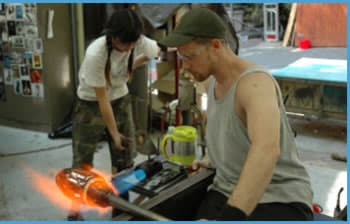The best introductions are made simply. The founder of Night Orbs knows who he is. “My name is Tom Rupnicki, and I believe in color.” Tom’s work has provided light to many landscapes throughout the country. His hands and vision have given enchanting pieces of artwork to some of the most prestigious venues, museums, galleries, and personal paradises across the globe. His glass works are happy fixtures in Healing Gardens in hospitals as well as night lights for backyard walkways. Each piece is blown custom and carries a unique experience. So what does the process behind Night Orbs look like?
Each NightOrb begins very simply. Before they’re even glass orbs, these Night Orbs are in their basic elements of powder and color. “The glass comes in bags in the powdered form’, explains Tom, ‘which needs to be added slowly to achieve the proper consistency.”
Tom and his Night Orbs crew create each piece in The East Falls Glassworks facility in the East Falls neighborhood of Philadelphia. The space allows them to fully cook the powder to get it to a temperature of 2350 degrees Fahrenheit. “That’s hot,” said Tom, with a big smile. ” To melt (the powder into) glass, you must cook at 2350 degrees”. Surprisingly, the sweltering heat from a six-ton furnace isn’t enough to produce the desired melting point.
“The powders have fluxes in order to reduce the melting point,” Tom continued, further discussing the cooking process. Fluxes are so necessary for glass blowing because of the tremendous amount of energy needed to produce these beautiful and ornate pieces. They reduce the melting point, simultaneously increasing the flow rate of the glass mixture. These fluxes also act as stabilizing agents that strengthen the glass as it embarks on a fiery journey. “Otherwise, the melting point wouldn’t be tip around 4000 degrees Fahrenheit,” Tom said, laughing, at which point you’d need a nuclear reactor to run the furnace!”
Once the furnace is up to the roaring 2350 degrees, Tom begins to add the powder 25 to 30 pounds at a time. “It’s a very slow process. Usually, it takes a full day to charge the glass before it’s ready”. Charging glass is similar to allowing yeast to rise in the dough – it just takes time, patience, and experience. The experience element is something that Tom takes very seriously. “The individuals that work on a Night Orb have anywhere from 5 to 10 years of experience in glass blowing. It’s important because blowing glass is one of the most expensive mediums to practice”.
After the Night Orbs team has enough molten glass to work with, Tom and his crew begin to massage the glass into form. It takes many stages to reach the final product, each step being just as vital as the last. “I call it ‘The Glass Dance,” Tom says, another smile forming across his face. You can really tell he loves his work by how many times he smiled and chuckled during this explanation. ‘It takes a team of artisans working in sync to create a dazzling glass-blown globe.” These pieces are a quarter inch thick, and a composition that large needs a great deal of attention. “Glass blowing is pretty tricky,” he continued. ‘You need unique skills to perform it properly”.
Once the shaping of the piece has occurred, the color can be added. Like the powder for the glass, the color comes in bars measuring 14 inches in length which are produced exclusively in Germany. “They have a secret formula for making the color bars. They’re the only ones that make what is needed for blown glass”.
The Night Orbs are spun round with melted color bars coating the sphere like taffy on a spinning ball. Each of the nine color patterns echoes a planet found in our solar system. Phobus is the most popular pattern, but Saturn is one Tom has a personal affection towards. “Saturn really is a gorgeous pattern.”
When each piece is finished, it’s ready for the outside world. Night Orbs can survive bitter cold winters and the Arizona heat – what’s 106 to a sphere forged in a 2350-degree furnace?). It can even survive landscapers and children. Tom wants his customers to be pleased with his work, but he’s unsure which is his favorite part. “The entire process is a lot of fun. Working with glass and making it is my favorite part of the process.”


